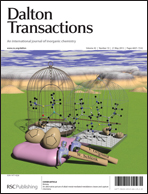In vitro and in vivo activity of a new unsymmetrical dinuclear copper complex containing a derivative ligand of 1,4,7-triazacyclononane: catalytic promiscuity of [Cu2(L)Cl3]†
Abstract
Here we present the synthesis of the dinuclear complex [CuII2(L)Cl3] (1), where L is the deprotonated form of the 3-[(4,7-diisopropyl-1,4,7-triazacyclononan-1-yl)methyl]-2-hydroxy-5-methylbenzaldehyde ligand. The complex was characterized by single crystal X-ray diffraction, potentiometric titration, mass spectrometry, electrochemical and magnetic measurements, EPR, UV-Vis and IR. Complex 1 is able to increase the hydrolysis rate of the diester bis-(2,4-dinitrophenyl)phosphate (2,4-BDNPP) by a factor of 2700, and also to promote the plasmidial DNA cleavage at pH 6 and to inhibit the formazan chromophore formation in redox processes at pH 7. Using Saccharomyces cerevisiae (BY4741) as a eukaryotic cellular model, we observed that 1 presents reduced cytotoxicity. In addition, treatment of wild-type and mutant cells lacking Cu/Zn-superoxide dismutase (Sod1) and cytoplasmic catalase (Ctt1) with 1 promotes increased survival after H2O2 or menadione (O2˙− generator) stress, indicating that 1 might act as a Sod1 and Ctt1 mimetic. Considered together, these results support considerations regarding the dynamic behaviour of an unsymmetrical dinuclear copper(II) complex in solid state and in aqueous pH-dependent solution.
![Graphical abstract: In vitro and in vivo activity of a new unsymmetrical dinuclear copper complex containing a derivative ligand of 1,4,7-triazacyclononane: catalytic promiscuity of [Cu2(L)Cl3]](/en/Image/Get?imageInfo.ImageType=GA&imageInfo.ImageIdentifier.ManuscriptID=C3DT33046J&imageInfo.ImageIdentifier.Year=2013)

 Please wait while we load your content...
Please wait while we load your content...